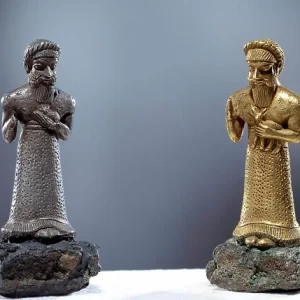Archaeologists have explored part of the Oweynagat cave, associated with the deadly night and later became the famous Halloween festival.

Oweynagat cave entrance, Ireland is said to be the gate to hell leading to the afterlife (Photo: Independent)
In the middle of a field in a little-known area of Ireland, there is a large mound of dirt. Nowadays this is a place for wandering sheep to graze, but in the past it was associated with many mystical events.
Sheep at that time may have been hung high by people living near Oweynagat cave, sacrificed to evil spirits.
This mound is located in Rathcroghan, the center of the ancient, Iron Age Kingdom of Connaught. Today, much of this area is buried beneath the farmland of county Roscommon, Ireland.
In 2021, Ireland applied for recognition of Rathcroghan as a World Heritage Site. Although this site is associated with the Halloween tradition, it is still on UNESCO’s review list.
Originated from legend
Rathcroghan is spread over several square kilometers of rich agricultural land, it includes 240 archaeological sites, dating back 5,500 years such as burial mounds, ringforts (settlements), Iron Age ceremonial sanctuaries and Oweynagat Cave, known as the gate to hell.
Irish archaeologist Daniel Curley said it was more than 2,000 years ago when Irish communities worshiped nature and the land. It was in Rathcroghan that the Irish “Samhain New Year” festival was born.

Small path leading into the cave (Photo: Independent).
In the 1800s, the Samhain tradition was introduced to the United States from Irish immigrants. It was quickly adopted by local people, who flocked to the streets, causing overcrowding and congestion on every street. It later became known as the Halloween festival.
Associate Professor Dorothy Ann Bray, McGill University (Ireland), explained that pre-Christian Irish people divided each year into summer and winter.
During that year, there are four festivals namely Imbolc; Bealtaine, marks the end of winter and includes customs such as washing your face in dew, picking the first blooming flowers and dancing around a decorated tree.
Lughnasadh, the harvest festival dedicated to the god Lugh and presided over by Irish kings, and finally Samhain (October 31), marked the end of one pastoral year and the beginning of another.
Rathcroghan is not a town, it is a royal settlement and an important location for the above mentioned festivals. During Samhain in particular, the site of Rathcroghan is where much of the activity focuses on the high temple, surrounded by the burial grounds of Connachta’s elite.
The remaining lower-class Connachta communities reside on scattered farms and only descend on the site for festivals. During the event, they traded, feasted, exchanged gifts, played games, arranged marriages and declared war or peace.
Festival participants may also have made ritual offerings, possibly directed to the otherworldly spirits of Ireland. They believe that this is where immortals live, as well as countless beasts, demons or monsters. And during Samhain, some of these creatures escaped their world through the cave of Oweynagat.

Today, the Halloween festival also affects Vietnam (Photo: Ciputra Hanoi).
Researcher Mike McCarthyc said: “Samhain takes place when the invisible wall between the living world and the afterlife disappears. A series of terrifying beasts from another world appear to wreak havoc on the surrounding landscape, standard get food for the winter”.
People protected themselves from these monsters by lighting fires and performing rituals on hilltops or fields. They disguised themselves as fellow vampires so they wouldn’t be dragged into the other world through the cave by demons.
The nation of Ireland is filled with so many historical sites that many go completely unnoticed. Some are hidden underground, abandoned centuries ago and then gradually destroyed by nature. It includes Rathcroghan, which some experts say may be Europe’s largest unexcavated royal complex.
Rathcroghan has never been excavated and, according to scientists, its existence predates Ireland’s written history. They uncovered the story of the site by using modern technologies to examine and analyze artifacts found in the vicinity.

The ancient Kingdom of Connaught as reconstructed by archaeologists (Photo: National Geographic).
While Irish people for centuries knew the site as the home of Rathcroghan, it was not until the 1990s that a team of Irish researchers used remote sensing technology to reveal the archaeological secrets beneath its heart. land.
“Targeted excavation will likely be undertaken soon, which will answer our research questions,” Curley said.
A location that still receives little attention
Despite its importance, Rathcroghan is one of the least visited attractions in Ireland, with only 22,000 visitors a year compared to the more than a million who visit the Cliffs of Moher, despite Rathcroghan being considered the birthplace of Halloween.
Rathcroghan’s reputation will soar, however, if Ireland succeeds in its bid to make it a UNESCO World Heritage Site. The government has included the area in its list of “Royal Irish Places”.
According to experts, the ability to promote Rathcroghan tourism globally thanks to UNESCO will likely attract more tourists to come here. But it seems unlikely this historic gem will be repackaged as a kitschy Halloween tourist attraction.
Researcher Curley said: “If Rathcroghan is recognized by UNESCO, it will attract more tourists, which will help the country have funds to preserve it. But we want this place to become a tourist area.” sustainable, with many values, not simply relying on the tourism fever associated with Halloween.”





